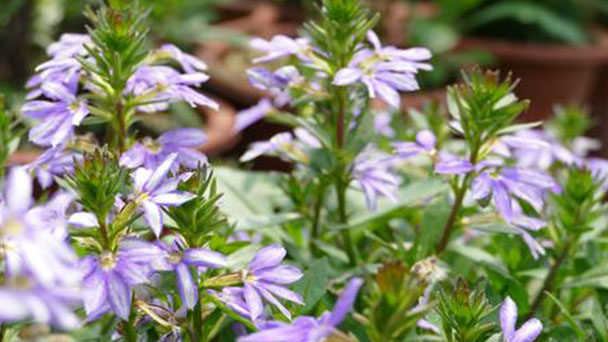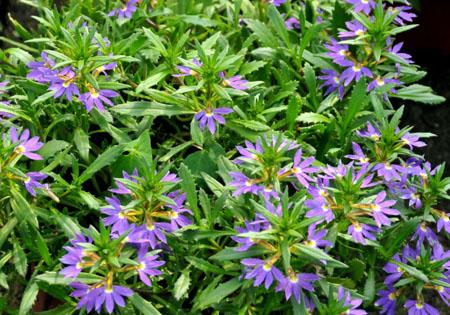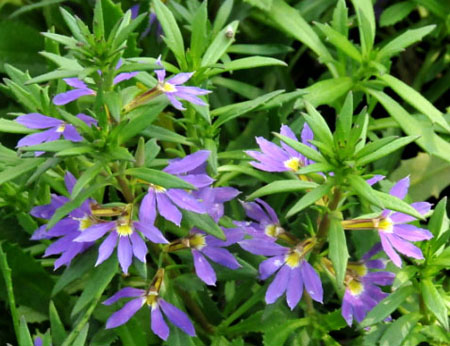Scaevola (fairy fan flower) profile
Written by Maggie
Aug 24 2021

Scaevola, also known as Fairy fan flower; fan flower, is a perennial grass flower of the genus Paulownia in the genus Paulownia, originally produced in Australia. It consists of five elongated elliptical purple and blue petals, which looks like a handful of folding fans after expansion, exquisite and beautiful.
Scaevola picture

Scaevola info
| Botanical Name | Scaevola aemula |
| Common Names | Fairy fan flower; fan flower |
| Plant Type | Annual |
| Sun | Full to partial sun |
| Hardiness Zones | USDA growing zones 10-11 |
| Flower color | Blue, purple, white, pink |
| Native Area | Australia |
| Mature size | Six to 12 inches tall, trailing to two feet |
Scaevola morphological characteristics
Leaves of Scaevola are reddish-brown or green, alternate or fascicular branch ends, sine-shaped elliptic or oblateolate, entire or trilobed. Flowers are axillary, corolla fan - shaped, long flowering. The semicircular corolla, composed of five long oval petals, is like a handful of folding fans.Each flower looks incomplete, as if it has been cut in half, but this is a characteristic of the grass tung family - the fan-shaped "half flower", which is very distinctive. The color has purple, lavender, pink, white and so on, the flower center is yellow.
Scaevola growing environment
Sunshine: Full sunshine.
Temperature: The suitable temperature for growth is 18℃ ~ 26℃.
Soil: Prefer sandy loam with good drainage.
Moisture: likes to be wet.
Scaevola distribution range
Origin: Australia.
How to grow and care for Scaevola
Light
Choose a website online with full to partial solar for first-class scaevola performance. Scaevola in hot, dry barren region areas may additionally stay extra pert when positioned in a place with dappled shade.
Soil
Rich soil isn't always integral for thriving scaevola plants. While soil of common fertility is fine, right drainage is an essential ingredient of wholesome plant growth. When developing in the ground, amend heavy clay soils or use raised beds.
Water
Scaevola pick to be on the dry side, however they are no longer actual xeriscape flowers and so do want occasional watering. Plants developing in moist soil can also entice fungus gnats, or can also trip root rot. Wait till the soil surface is dry to water. Wilted plant life will perk up shortly after irrigation.
Temperature and humidity
Scaevola develop vigorously in heat to warm weather. Temperatures beneath 60 tiers F will reason flowering to gradual or stop. Temperatures between 70 and eighty five tiers yield the happiest flora with compact growth, however warm temperatures are additionally properly tolerated. High humidity is welcomed through the scaevola.
Fertilizer
Accustomed to the lean developing prerequisites of its native Australia, scaevola flora require solely a mild feeding. Choose a balanced flower fertilizer low in phosphorus, which can motive flower and foliage discoloration. Apply the fertilizer as soon as a month all through the developing season.
Repotting
A light-weight potting combine will aid your container-grown scaevola plants. If you stay in a place with sandy soil, you can additionally combine this in with your potting soil to stretch your resources. Plants generally end their existence cycle barring the want to be repotted.
Pruning
Like most trailing annuals, scaevola has advantages from a little snipping right here and there to maintain it tidy and to inspire the plant to develop in a branching habit, instead of creating long, lanky stems. Scaevola is self-cleaning and does not now want to be deadheaded, however you can reduce it returned through half of after the first huge flush of blooms to inspire new increase and spur even extra flowering. More about how to care for Scaevola.

Scaevola pests/diseases
Like many Australian natives, scaevola is a difficult specimen, and does not go through from many pest or sickness problems. Scaevola confused through prolonged drought may additionally entice thrips. Avoid spraying scaevola for insects, as the flora are a necessary supply of nectar for butterflies.
How to grow Scaevola in containers
The container backyard is the place scaevola flowers truly shine. Place them at the front of the pot, the place they can drape over the facet and conceal the rim. Scaevola flora make precise companions for different warm climate fanatics for sun, like Mexican zinnias, zonal geraniums, and tropical hibiscus. Like the scaevola, these plant life want exact draining soil and do not like to be overwatered.
How to grow Scaevola from seeds
Scaevola can be elaborate to develop from seed. Fresh seed has the easiest germination rate. Sow in the spring about two months earlier than your remaining frost in a gritty potting mix. Mist lightly, and hold seeds at about 70 tiers F. Germination might also show up in 14 to 21 days.
Scaevola propagtion
Take cuttings of scaevola at the quit of summer time to overwinter the plants. Take a slicing from a non-blooming stem. Dip the give up of the slicing in rooting hormone, and insert the cease into sterile potting mix. Keep the reducing barely moist, as overwatering will purpose damping-off disease. Roots will shape in about one month.
Varieties of Scaevola
Scaevola 'Purple Fanfare'
Scaevola 'Purple Fanfare' Harley Seaway/Getty Images
Scaevola 'White Carpet'
The 'Fairy' sequence of scaevola points compact, six-inch tall plant life in blue, pink, or white. The 'Whirlwind' collection is a lively grower, and will unfold to fill in gaps in your containers or borders. 'Purple Fanfare' provides masses of lavender-blue blooms in the course of the developing season. Those in the 'Carpet' collection structure a dense floor cover.
Toxicity of Scaevola
While scaevola is now not fit to be eaten, it does not have any recognised poisonous effects.
Scaevola main value
The design and color of Scaevola is elegant, the flower shape is peculiarly potted and can be used for the balcony, window sill or the study decoration; Scaevola is suitable for parks, courtyards and other roadside, flower beds cultivation and ornamental, or as ground cover plants.

Latest Updated
- Benefits of Bugleweed - 7 Science-backed Health Benefits
- Bugleweed Dangers & Side Effects - Is It Poisonous?
- How to Plant Evergreen Trees - What You Should Know
- When to Plant Evergreens - Grow Guide for Evergreen Trees
- 12 Wonderful Evergreen Shrubs for Your Garden
- 12 Popular Evergreen Plants with Pictures for Beginners
- When And How To Prune A Lilac Bush Like a Pro
- How to Grow & Care for Lilac Vine (Hardenbergia Violacea)
- Japanese Lilac Tree (Syringa Reticulata) Care & Propagation Guide
- Shumard Oak Pros and Cons - What to Know
Popular Articles
- Winter maintenance of Antirrhinum Majus
- How to Grow Terminalia Mantaly Tree
- How to Grow and Care for Crossostephium Chinense
- How to grow Antirrhinum Majus in spring
- Peristeria Elata (Dove Orchid) Profile: Info & Care Guide
- Underwatered Snake Plant (Sansevieria Trifasciata) - Signs And How To Fix
- How to Care for Brazilian Jasmine Plant (Mandevilla Sanderi)
- How to Grow & Care for Graptopetalum Purple Delight in Summer
- Rosa Chinensis (China Rose): Plant Growing & Care Tips
- How to Care for Baby Sun Rose (Aptenia Cordifolia)